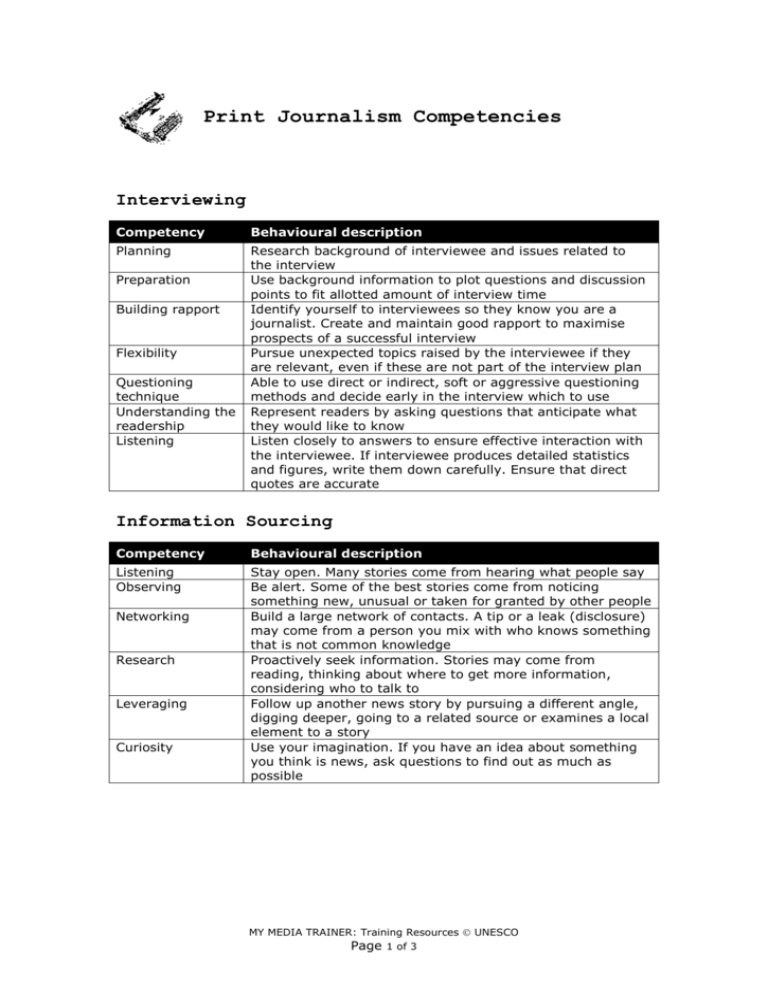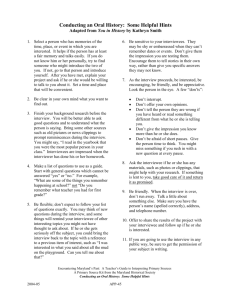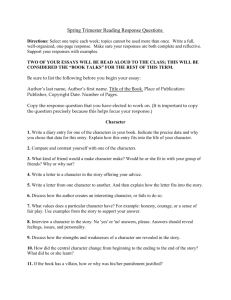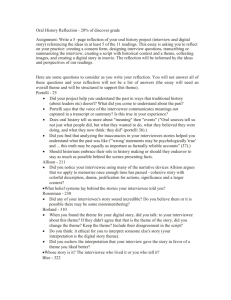Print journalism competencies
advertisement

Print Journalism Competencies Interviewing Competency Behavioural description Planning Research background of interviewee and issues related to the interview Use background information to plot questions and discussion points to fit allotted amount of interview time Identify yourself to interviewees so they know you are a journalist. Create and maintain good rapport to maximise prospects of a successful interview Pursue unexpected topics raised by the interviewee if they are relevant, even if these are not part of the interview plan Able to use direct or indirect, soft or aggressive questioning methods and decide early in the interview which to use Represent readers by asking questions that anticipate what they would like to know Listen closely to answers to ensure effective interaction with the interviewee. If interviewee produces detailed statistics and figures, write them down carefully. Ensure that direct quotes are accurate Preparation Building rapport Flexibility Questioning technique Understanding the readership Listening Information Sourcing Competency Behavioural description Listening Observing Stay open. Many stories come from hearing what people say Be alert. Some of the best stories come from noticing something new, unusual or taken for granted by other people Build a large network of contacts. A tip or a leak (disclosure) may come from a person you mix with who knows something that is not common knowledge Proactively seek information. Stories may come from reading, thinking about where to get more information, considering who to talk to Follow up another news story by pursuing a different angle, digging deeper, going to a related source or examines a local element to a story Use your imagination. If you have an idea about something you think is news, ask questions to find out as much as possible Networking Research Leveraging Curiosity MY MEDIA TRAINER: Training Resources UNESCO Page 1 of 3 News Gathering [Reporting] Competency Behavioural description Understanding news types Know how different types of news can be used. Hard news immediate or breaking story. Soft news - A non-urgent story that can wait for publication. Feature - In-depth story. Profile - Explores a person in the news. Backgrounder - A story providing additional information on a news event Be responsive. Much news is hard news – based on events that have just occurred or are still happening [breaking news] Real people provide the essence of a good story and provide information, anecdotes and quotes. Unexpected information that takes a story in a different direction. Always identify who you are and that you are a reporter before beginning an interview. Ask permission and inform the source if you want to publish something they say Focus on facts, not opinion. Credible sources. Understand how statistics work. Fairness in news coverage. Critical thinking applied to news events and information Rapid reaction Interviewing skills Reporting skills News Writing Competency Behavioural description News sense Understand concepts of impact, immediacy, newsworthiness and perishability of news. Newsworthiness - decide what is relevant to readers by thinking about their needs Know the three sections of an article: the lead (first paragraph); the body (main part of story); the ending (final pithy paragraph). Structure often referred to as an inverted pyramid because the main, and most important, point is contained in the first sentence. The rest of the story contains elements of less importance The most important part of a news story. In a single paragraph, write the lead to summarise the basic facts of a story and catch the reader's attention. Simple rule about news leads, the 5 W's - Who? What? Where? When? Why? The main idea of a news story that the rest of the story will support. Also referred to as the hook because it is used to grab the reader's attention. Sort through the facts that were gathered from the reporting and determine the theme. To find a compelling angle, think about SIN – material that is Significant, Interesting and New Write the body to support the lead and organise in the inverted pyramid style in declining importance. After the lead, a story may have a theme paragraph that spells out the theme or sub-themes. Story then proceeds with sections that explore the theme and sub-themes in more detail, and in order. Support with background facts and relevant quotes. Story should proceed in a logical way. Outlining the story with bullet points can help provide a logical structure. Ensure the story flows – that the string of ideas and sub-themes is connected by writing transitions Story organisation Writing the lead Deciding the angle Crafting the body of a story MY MEDIA TRAINER: Training Resources UNESCO Page 2 of 3 Writing the ending Headline writing Know the different ways to end your article. Inverted pyramid stories don't need a strong ending since they finish when there is nothing more to say. Other kinds of news stories (eg. the hourglass structure) need a good ending. One way to end is with a kicker, which is a catchy quote or a bizarre twist. Another effective ending is to conclude with a quote or anecdote that relates the story back to the main theme and leaves the reader thinking about the essence of the story. Avoid preaching or lecturing at the end of the story Know how to use headlines to: express the main idea of the story; effectively identify content; create reader interest; move readers into the story; be a good fit with the lead; use short, common, colourful, powerful words Deadline Writing Competency Behavioural description Developing the lead While reporting an event, consider at each point what the potential lead might look like. Mentally compose the lead and the first few paragraphs. If you don’t have a good lead but know in general what you want to say, to save time move on to the body of the story and go back to the lead later. Keep rewriting the lead until the last minute Assemble the story in your head even as you're reporting it. Report every detail you can, you never know what might come in useful. Revise as you go – read and revise the story as often as you can Avoid freezing on deadline by starting typing even if you’re not sure where the story will go. The act of typing will free you up Tell a colleague what you’re writing. It can force you to distil the main point of the story Make a quick list of the highlights of the story, so as not to miss any. Do a quick outline to make sure the story flows logically without repetition Get a start on the story before you go out to report it. Do your background research; even do some writing. Find out about the issue and the people involved. Think of the questions that need to be asked Organising as you go Don't get bogged down Sharing the problem Outlining Doing your homework MY MEDIA TRAINER: Training Resources UNESCO Page 3 of 3






